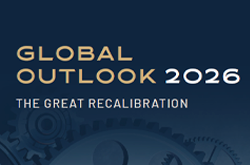Latest developments and impact on our scenario
What are the key developments since last week’s Flash?
- The Chinese February PMIs came out way below expectations and far below 2008-2009 levels (35 on manufacturing and 29 on services), reflecting the macro impact of the virus due to company closures. However, the number of cases is peaking and factories are reopening so we can anticipate a PMI rebound.
- The coronavirus continues to spread to a long list of countries, with a limited number of reported cases so far, but these are expected to increase. Preventive measures limiting travel and public events are accelerating in Europe. Some governments in Europe are warning that their 2020 GDP growth could be revised by 0.3-0.4%.
- International institutions such as the OECD are revising their scenario to reflect weaker growth in Q1-20.
- Equities have lost 15% in 6 days, with record volatility before rebounding on the back of monetary easing.
- The Federal Reserve has announced an exceptional 50 basis points cut in the federal funds rate ahead of the FOMC meeting scheduled for March 18; this is the first inter-meeting cut decided by the Fed since 2008.
- This is both a preventive and an emergency measure aimed at avoiding macro and financial contagion.
- Mr Powell mentioned that the outbreak would require a multi-faceted response; Fed’s action will probably be followed by additional coordinated monetary easing by other central banks and also greater fiscal support.
- In that respect we note that Chinese authorities have announced an RMB 3 trillion plan of additional liquidity and should increase public spending to offset the effects of the virus and keep GDP growth close to 6%.
How does this affect our investment scenario?
- We think that GDP growth will be weak in Q1-2020 notably in China as evidenced by record-low PMIs, and potentially a weak Q2 GDP growth in Europe. We think that this event is both a demand shock (due to preventive measures) and a supply side shock caused by short-term disruption of global value chains.
- The full year effects on GDP could be moderate if the global spread of the epidemic remains limited, and if fiscal / monetary measures start to transmit to GDP. In this case full year GDP growth could remain close to 3%; a bear case regarding the virus and policy mix could take global GDP growth below 2.5% in full year 2020.
- We think that earnings will be affected and revisions are expected to accelerate; we have lowered our EPS growth expectations by 3 to 4 points in the US and Europe, but they should stay in low positive territory.
- However, we think that these revisions are quite well priced-in by the 15% equity market correction.
- We also think that this situation is redistributing value between sectors (defensive versus cyclicals), and within sectors, between online and traditional distribution models, between quality and leveraged companies.
- In Europe, we anticipated an increase in high-yield spreads before the coronavirus crisis started; we now anticipate that the default rate of leveraged companies could increase from around 2% to potentially 3%.
- Oil prices have dropped below the USD 50-60/barrel range, affected by a drop of 20% in demand from China.
- Regarding forex markets, the Fed action is a game changer, with EUR/USD back to 1.12. We had called for a weakening dollar in 2020 but this call was dropped in February due to widening gaps of economic surprises. We became more cautious again on the USD over the past 2 weeks given the rally and potential Fed actions.
What remains valid in our 2020 outlook?
- Global growth still close to 3% with a policy mix that is globally supportive.
- We had advertised in our Global Outlook a positive long-term view regarding emerging markets and domestic Chinese equities in particular. We maintain this constructive call view despite the coronavirus.
- The February correction and additional volatility phases can be opportunities to build exposure to a market that represents more than 15% of the world economy but carries a much lower weight in world indices.
- Additional monetary easing by the Fed could become favourable to emerging markets.
- We continue to see more value in equities than in government bonds and credit in the long run.
- In Europe and in the US, we continue to prefer quality companies with earnings visibility and low leverage, but we are becoming more cautious on companies which business models are based on global trade or tourism.
- Oil prices could come back to USD 50/barrel in the second half of this year on the back of OPEC cuts and a rebound in demand from China.
- As regards currencies, we think that rate cuts could continue to pressure the USD due to a lower relative carry. This depreciation could be capped though, given that monetary easing is also expected in Europe. Any surprise action by the Fed could be the catalyst for emerging currencies to bounce back.
- We think that investment flows towards environment and digital themes will continue to be strong.
March 04, 2020




